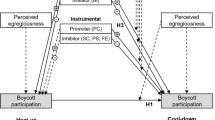Abstract
We develop a model that predicts changes in household consumption following a mean preserving increase in consumption inequality. The model allows for multiple peer-groups (a high-consumption (HC) group and a low-consumption (LC) group) as well different degrees of conspicuousness between the goods. We find that following a mean preserving increase in consumption inequality, a household with a constant level of income will increase its consumption of the more conspicuous good when it has preferences consistent with (i) ‘keeping up with the Joneses’ and a relatively stronger HC effect or (ii) ‘running away from the Joneses’ and a relatively stronger LC effect. Using U.S. consumer expenditure data from 1986 to 2002, we find tremendous heterogeneity in household preferences. While U.S. households consistently demonstrate ‘keeping up with the Joneses’, the relative strengths of HC and LC effects vary across racial sub-groups as well as across goods. Likewise, while expenditure on clothing, jewelry, personal care, etc., is generally more conspicuous than expenditure on healthcare, home furnishings, vehicle maintenance, etc., among the LC group, it is less conspicuous among the HC group with some heterogeneity by race. We conclude that heterogeneity in preferences is a likely explanation for the differences in the observed relationship between conspicuous spending and peer group inequality.
Similar content being viewed by others
References
Attanasio, O., Berloffa, G., Blundell, R., Preston, I.: From earnings inequality to consumption inequality. The Econ. J. 112, C52–C59 (2002)
Banerjee, A., Duflo, E.: Inequality and growth: What can the data say? J. of Econ. Growth. 8(3), 267–299 (2003)
Bowles, S., Park, Y.: Emulation, inequality, and work hours: Was Thorsten Veblen right? Econ. J. 115, F397–F412 (2005)
Bramoulle, Y., Djebbari, H., Fortin, B.: Identification of peer effects through social networks. J. of Econometrics. 150, 41–55 (2009)
Burbidge, J., Magee, L., Robb, A.L.: Alternative transformations to handle extreme values of the dependent variable. J. of the American Stat. Assoc. 83, 123–127 (1988)
Cameron, A.C., Trivedi, P.: Microeconometrics: Methods and Applications. Cambridge University Press, New York City (2005)
Carlsson, F., Johansson-Stenman, O., Martinsson, P.: Do you enjoy having more than others? Survey evidence of positional goods. Economica. 74, 586–598 (2007)
Chai, A., Kaus, W., Kiedaisch, C.: Conspicuous spending and the income distribution of social groups. Working Paper. Available at http://www.econ.uzh.ch/dam/jcr:4192a3385f-4d98-9f2b-0fc70136645a/Status_Inequality.pdf (2017)
Charles, K.K., Hurst, E., Roussanov, N.: Conspicuous consumption and race. Quart. J. of Econ. 124, 425–467 (2009)
Chugh, S.: Relative consumption benchmarks. Econ. Letters. 100, 204–207 (2008)
Cingano, F.: “Trends in income inequality and its impact on economic growth”, OECD Social, Employment and Migration Working Papers, No. 163, OECD Publishing. https://doi.org/10.1787/5jxrjncwxv6j-en (2014)
Cojocaru, A.: Fairness and inequality tolerance: Evidence from the life in transition survey. J. of Comparative Econ. 42, 590–608 (2014)
D’Ambrosio, C., Frick, J.: Individual wellbeing in a dynamic perspective. Economica. 79, 284–302 (2012)
De Girogi, G., Pellizzari, M., Redaelli, S.: Identification of social interactions through partially overlapping peer groups. Am. Econ. J.: Applied Econ., April, 241–275 (2010)
Deaton, A.: Health, inequality, and economic development. J. of Econ. Lit. 41, 113–158 (2003)
Dupor, B., Liu, W.F.: Jealousy and equilibrium overconsumption. Am. Econ. Rev. 93, 423–428 (2003)
Fehr, E., Schmidt, K.: A theory of fairness, competition, and cooperation. Quart. J. of Econ. 114, 817–868 (1999)
Ferrer, A.: Signalling, inequality, and the social structure. Economica. 72, 515–529 (2005)
Fisher, J., Johnson, D., Smeeding, T.: Measuring trends in inequality of individuals and families: Income and consumption. Am. Econ. Rev. 103, 184–188 (2013)
Frank, R.: The demand for unobservable and other nonpositional goods. Am. Econ. Rev. 75, 101–116 (1985)
Friedman, D., Ostrov, D.: Conspicuous consumption dynamics. Games and Econ. Behavior. 64, 121–145 (2008)
Glazer, A., Konrad, K.: A signaling explanation for charity. Am. Econ. Rev. 86, 1019–1028 (1996)
Heffetz, O.: A test of conspicuous consumption: Visibility and income elasticities. Rev. of Econ. and Stat. XCIII, 1101–1117 (2011)
Hirsch, F.: Social Limits to Growth. Harvard University Press, Massachusetts (1976)
Hopkins, E., Kornienko, T.: Status, Affluence, and Inequality: Rank-based Comparisons in Games of Status. Games and Econ. Behavior. 67, 552–568 (2009)
Jinkins, D.: Conspicuous consumption in the United States and China. J. of Econ. Behavior and Org. 127, 115–132 (2016)
Kelly, M.: Inequality and crime. Rev. of Econ. and Stat. 82, 530–539 (2000)
Krueger, D., Perri, F.: Does income inequality lead to consumption inequality? Evidence and theory. Rev. of Econ. Studies. 73, 163–193 (2006)
Lee, L.F.: Identification and estimation of econometric models with group interactions, contextual factors, and fixed effects. J. of Econometrics. 140, 333–374 (2007)
Manski, C.: Identification of endogenous social effects: The reflection problem. Rev. of Econ. Studies. 60, 531–542 (1993)
Meyer, B., Sullivan, J.: Consumption and income inequality and the great recession. Am. Econ. Rev. 103, 178–183 (2013)
Mujcic, R., Frijters, P.: Conspicuous consumption, conspicuous health, and optimal taxation. J. of Econ. Behavior and Org. 111, 59–70 (2015)
Oxoby, R.: Attitudes and allocations: status, cognitive dissonance, and the manipulation of attitudes. J. of Econ. Behavior and Org. 52, 365–385 (2003)
Oxoby, R.: Cognitive dissonance, status and growth of the underclass. Econ. J. 114, 727–749 (2004)
Roychowdhury, P.: Visible inequality, status competition, and conspicuous consumption: Evidence from rural India. Oxford Econ. Papers. 69, 36–54 (2017)
Solnick, S., Hemenway, D.: Are positional concerns stronger in some domains than in others? Am. Econ. Rev. 95, 147–155 (2005)
Torras, M., Boyce, J.: Income, inequality, and pollution: A reassessment of the environmental Kuznets curve. Ecol. Econ. 25, 147–160 (1998)
Author information
Authors and Affiliations
Corresponding author
Additional information
Publisher’s Note
Springer Nature remains neutral with regard to jurisdictional claims in published maps and institutional affiliations.
Rights and permissions
About this article
Cite this article
Harriger-Lin, J., Khanna, N. & Pape, A. Conspicuous consumption and peer-group inequality: the role of preferences. J Econ Inequal 18, 365–389 (2020). https://doi.org/10.1007/s10888-020-09447-6
Received:
Accepted:
Published:
Issue Date:
DOI: https://doi.org/10.1007/s10888-020-09447-6




